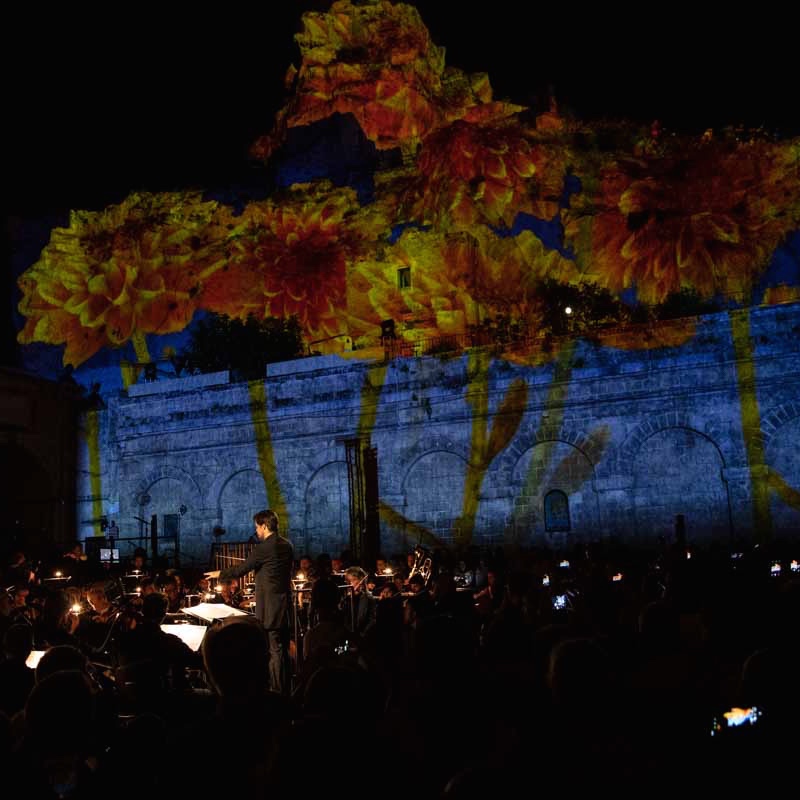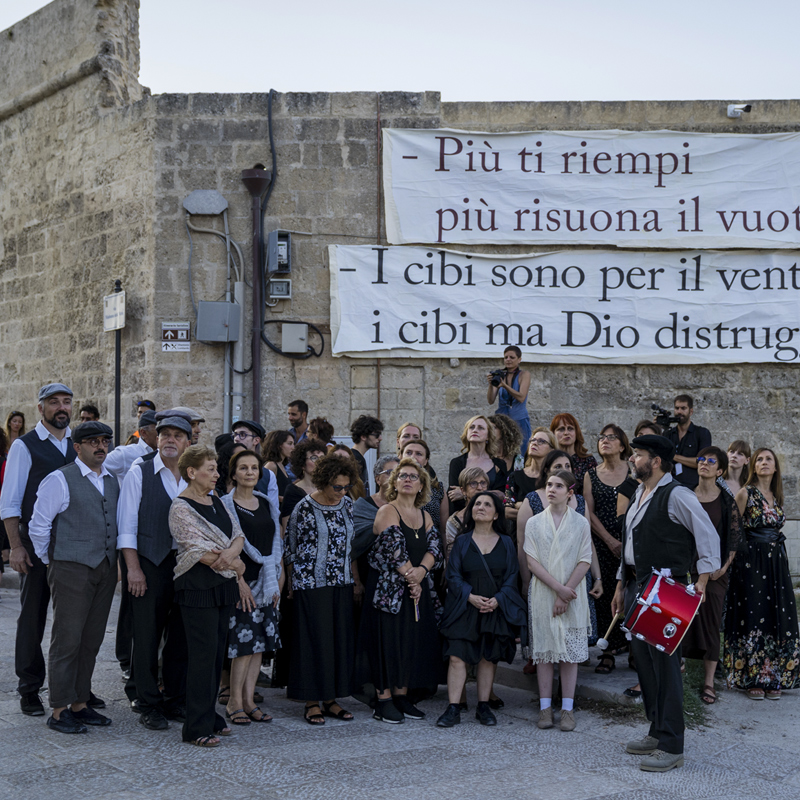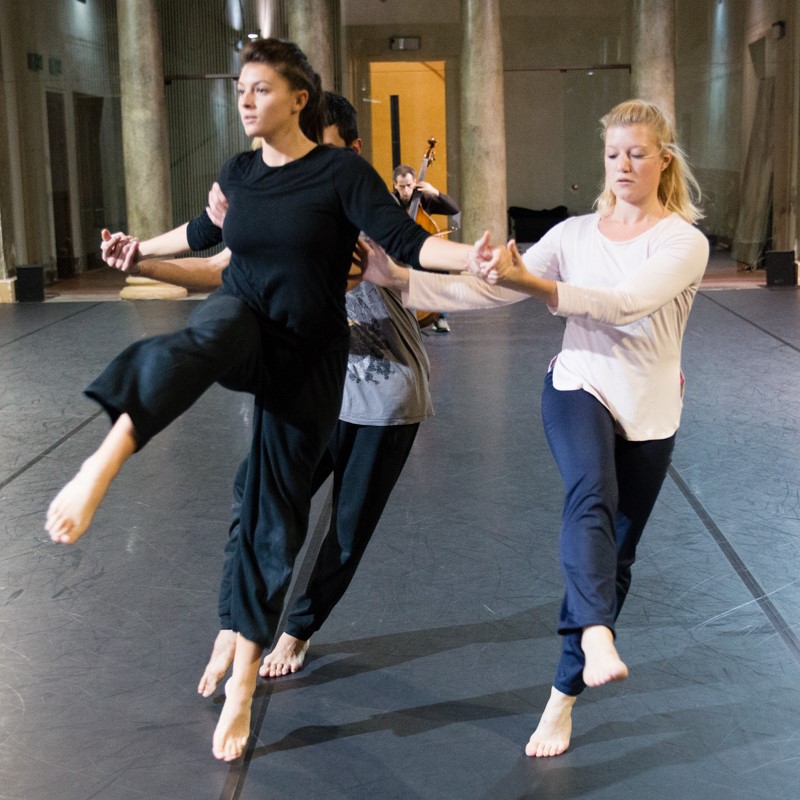Home
Inhabiting the Opera, an opera among the Sassi stone districts

One of the most intense moments of the Matera 2019 cultural programme was performed between 31 July and 3 August: Abitare l’Opera (Inhabiting the Opera), a major cultural production produced with one of the oldest theatres in the world, the San Carlo Theatre of Naples. Bringing opera to the great natural stage of the Sassi on a walkway in the middle of the audience, which brought it into direct contact with the action on stage, proved to be a great success with the public, and a winning gamble.
Over a thousand spectators applauded "Cavalleria Rusticana” in a Piazza San Pietro Caveoso that had been transformed into a stage, using the façade of the Church of Santa Maria di Idris for the spectacular video projections. The event was broadcast live on Rai5 on Saturday 3 August, directed by Giorgio Barberio Corsetti, with orchestra and choir conducted by Juraj Valcuha and a cast including Veronica Simeoni, Roberto Aronica and George Gagnidze.
The prologue to "The Seven Capital(ist) Sins”, which denounces excesses in liberalism, involved dividing citizens into stations. At each station, a choir of citizens sang popular songs associated with the various sins – pride, sloth, lust, wrath, gluttony, envy and greed – with the extraordinary scenery of the Sassi at sunset creating a theatrical setting.
The long, evocative pathways were characterised by modernity and tradition, recounting the weaknesses of humanity in performances, followed by two large masks set opposite each other – good and evil, which often represent both sides of the same coin in our everyday lives.
Greeted with applause and standing ovations, the performances of Abitare (Inhabiting) offered its audiences an extraordinary immersive experience. “Cavalleria Rusticana” was broadcast on television throughout Switzerland, and Arte also broadcast the event in Switzerland, France, Germany, Belgium, Austria, Lichtenstein, Luxembourg, the Principality of Monaco and French-speaking countries across the ocean. From the middle of August, the opera will be presented in Japan, Hungary, Slovenia and Greece. Between 2019 and 2020, “Cavalleria Rusticana” will be distributed to cinemas in Europe, Korea, the United States and Latin America. It will be available on DVD from Spring 2020.
Inhabiting the Opera: rediscovering being citizens through participation

The story told by the citizens who took part in the staging of the prologue to Cavalleria Rusticana, directed by Giorgio Barberio Corsetti, was a reappropriation, and in some ways a reconciliation. The travelling performance at the Sassi, a modern version of the Seven Deadly Sins viewed from a "Capitalist" standpoint was an integral part of the "Inhabiting the Opera" project, accompanying audiences towards Pietro Mascagni's work, which was performed in Piazza San Pietro Caveoso by the Orchestra of the San Carlo Theatre of Naples.
It was a unique experiment uniting people from very different contexts who came together to form a company that enlivened the ancient streets, which were not just a splendid backdrop but an essential component of the performance. Citizens and professional artists joined together to bring one of the most important productions of the year as European Capital of Culture to life.
Reappropriation was achieved in part through the Sassi. The citizens who made up the chorus that backed up the scenes acted by the artists sang traditional songs from the city and the entire region. On one condition, however, that was very clear from the outset: the choir’s purpose was not to search for a pure dialect that is sometimes claimed to be the mother tongue, only to be humiliated through usages that only seek self-satisfaction. The raison d'être of popular songs was to communicate a universal message that transcended a kind of localism of identity. Singing these songs today in the same streets where they had resounded thousands of times with a different sort of awareness was the challenge faced by the citizens who took part in Inhabiting the Opera, a challenge they can be said to have met.
The same can also be said of the artists – some of whom were originally from Matera – who told of a kind of reconciliation. It is a phenomenon that enables you to make peace with yourself and your land after you have left it and only return to it and take it in hand when you are an adult.
It is in this sequence of intimate, profound feelings that inspired those who took part in this unique experience that the unusual strength of Inhabiting the Opera can be found.
Matera 2019 at Jova Beach Party in Policoro

Jova Beach Party, one of the best shows of summer 2019 will stop in Basilicata on the beach of Policoro, in the locality Torre Mozza.
A great show with the most popular songs of Jovanotti, some of the most famous Italian hits.
If you already have your ticket for this event, you are allowed to come to our *infopoints and to buy the Matera 2019 passport for only 12 euros instead of 19 euros, the all-in-one ticket that includes unlimited access to all the official events of Matera European Capital Of Culture 2019 throughout the entire year.
* Matera 2019 infopoints
Matera | Via Lucana 125-127
Matera | Museo Nazionale d'arte medievale e moderna della Basilicata di Palazzo Lanfranchi
Metaponto | Museo Archeologico Nazionale
Call for dancers | Workshop “Tactile Space”

The workshop “Tactile Space” will be led by Virgilio Sieni and Giuseppe Comuniello, a blind dancer, and is part of the project Tauma Atlante del Gesto, research carried out by Virgilio Sieni within the program I-DEA and produced by Matera 2019.
The workshop will be held in the Teatro Quaroni at La Martella (Matera) and is open to dancers, performers and actors (over 18 years old) who want to develop the theme of tactile space, which means exploring the relationship between men and the environment as a mean towards inclusion.
The workshop will be held from the 23rd to the 27th of September 2019 every day from 3pm to 5pm.
Every applicant will need to email a copy of their CV to the address This email address is being protected from spambots. You need JavaScript enabled to view it. and fill in the following form.
It will be possible to apply until Tuesday September 10th, the decisions of the choreographer will be communicated in the following days.
Workshop Description:
The workshop “Tactile Space” will be led by Virgilio Sieni and Giuseppe Comuniello, a blind dancer, and is open to dancers, performers and actors (over 18 years old) who want to develop the theme of tactile space, which means exploring the relationship between men and the environment as a mean towards inclusion. Through the workshop a variety of themes will be explored, and participants will learn how empathy developed through gestures and closeness can transform our relationship with others and our surroundings. Openness and inclusion will be the main focus of the workshop, deriving directly from the research on tactiles spaces.





